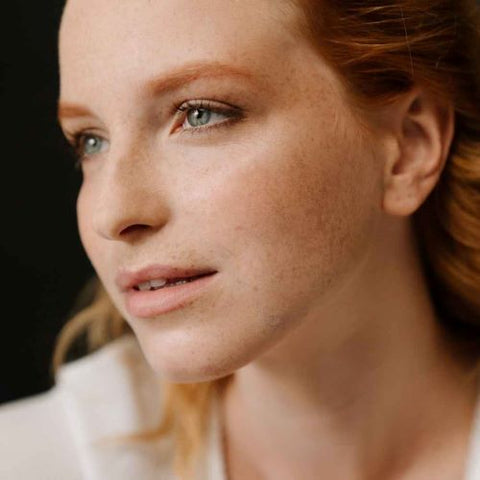Have you ever heard of phototype? Also known as the Fitzpatrick classification, it is a way of classifying the sensitivity of your skin to UV radiation.
As you know, we are not all equal when it comes to the sun. From one skin to another, the production of melanin can be considerably different. There are 7 phototypes, including the very rare phototype 0, which corresponds to albinos.
It is obvious today that a fair skin is much more sensitive to UV rays than a dark skin, nevertheless sun protection is strongly advised for all skin types, as the consequences of long exposure to the sun are present including skin ageing and skin cancers. For this reason, we encourage you to identify your phototype in order to provide you with advice on appropriate sun protection.
Phototype 0 (very rare): very pale skin
Physical characteristics: very pale skin, white (or pale yellow) hair and light coloured eyes.

Phototype 0 is very rare and usually corresponds to people with albinism: a genetic mutation that directly affects the pigmentation of the skin by making it paler (or slightly pinker). Thus, the person with phototype 0 produces little or no melanin, which makes them extremely sensitive to the sun. The risk of burning or skin cancer is much greater.
Phototype 1: very fair skin
Physical characteristics: very light skin, red or blond hair, light eyes (blue or green), possible freckles and moles.

Phototype 1 has quite sensitive skin and freckles may appear when exposed to the sun. In this case, the skin is unable to tan and can only withstand sunburn for 10 minutes at a UV index of 10.
Phototype 2: very fair skin (possibly tanned)
Physical characteristics: very fair skin, blond or light brown hair, blue, green or grey eyes, freckles visible in the sun, only slightly tanned.

Phototype 2 and phototype 1 share many characteristics such as very fair skin and freckles that are visible in the sun. However, phototype 2 skin can tan, but is still very sensitive to UV radiation.
Thus, it is not possible to tan without sunburns or burns that can occur after 10 to 20 minutes of exposure.
Phototype 3: fair (or matt) skin
Physical characteristics: fair (or dark) skin, blond to brown hair, few or no freckles.

Unlike the previous phototypes, phototype 3 is intermediate. It has a skin that is more resistant to UV rays, so its tanning is average and burns are more moderate.
Note that the consequences of sun exposure may vary for phototype 3, depending on hair or eye colour. Phototype 3s with blond hair or light eyes have a faster skin ageing process than brown people with dark eyes.
However, it is important to remain vigilant, as sunburns can occur after about 20 minutes of exposure with a UV index of 10.
Note that phototype 3 has an increased risk of skin cancer from 50 moles onwards and should be monitored by a specialist.
Phototype 4: matt skin
Physical characteristics: dark skin, dark brown or brown hair, brown eyes

Phototype 4 has a skin that is fairly resistant to the sun, it tans easily. It takes 30 minutes of exposure before you get sunburned with a UV index of 10.
We advise you to remain cautious and to use sun protection according to the duration of your outdoor activities.
Phototype 5: brown skin
Physical characteristics: brown or dark skin, brown hair, brown eyes.

Phototype 5 has a skin that is very resistant to UV rays, tans easily and only gets sunburned after 60 minutes of exposure.
Same case as for phototype 4, a brown skin is not exempt from sun protection. Skin cancer can occur on all phototypes, even the darkest. Your skin may suffer from dryness and long-term ageing. Therefore, it is also important to moisturise your skin.
Phototype 6: black skin
Physical characteristics: black skin, brown hair, brown eyes.

Phototype 6 has a high resistance to the sun. Their skin produces much more melanin. The consequences of exposure only appear after 90 minutes. Indeed, phototype 6 will not get sunburned (or only slightly), however, it is possible to get blistering burns.
Having black skin is not exempt from sun protection. The impact on skin ageing can be significant. Thus, sun protection should be prescribed.
Depending on my phototype, how long does it take me to burn?

This curve is taken from the scientific study by J. F. Sánchez-Pérez, and shows us the time of exposure to get a sunburn according to one's phototype (1, 2, 3 or 4) and the UV index.
The sun protection to be adapted will therefore depend on the phototype, the UV index and the exposure time. In summer, a UV index of 10 or 11 is common in France today.
Sources :
https://www.who.int/news-room/questions-and-answers/item/radiation-sun-protection
https://www.nature.com/articles/s41598-018-36850-x



Partager:
3 comments
phototype 5
j’ai 59 ans et depuis quelques années j’ai des tâches brunes sur le visage j’ai eu des traitements et je me protège avec une crème solaire et c’est pourquoi j’ai commandé un chapeau sur votre site que j’ai connu par une collègue
Bonjour
Votre étude et vos informations sont très intéressantes et méritent que le plus grand nombre en prenne connaissance .
Une fois sensibilisé, nous devrions appliquer vos conseils avec rigueur.
Cordialement
Merci pour vos informations qui sont très bien expliquées, et qui permettra sans aucun doute de commettre moins d’erreurs sur le choix des textiles et des crèmes solaires.